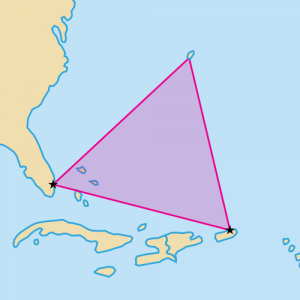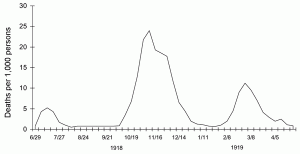The Texas sharpshooter fallacy is one of the most amusing fallacies in Critical Thinking: perhaps because it is based on a story. The Texas sharpshooter is a man who practices shooting by putting bullet-holes in his barn wall: then, when there is a cluster of holes in the wall, he draws a target around them. To commit the Texas Sharpshooter Fallacy, then, is to fit your theory to a pre-existing pattern of coincidences.
This video is an advert for a book, but presents the fallacy rather well:
The cognitive bias that might lead us into the Texas Sharpshooter Fallacy is called the Clustering Illusion. If we see a cluster of something (bullet holes, cancer cases, high grades in exams, letters used in a text) we have a tendency to assume that this cluster must be significant. Of course, it might be, but then it might not be. I think the fallacy becomes a metaphysical assumption about a ‘truth’ in the world around us when we assume that the pattern must be there, rather than just holding it provisionally as a possibility. Usually we need to look at a lot more evidence and continue to see the same pattern before we can justifiably conclude that the theory that explains it.
The Middle Way is applicable here because we need to avoid either, on the one hand, jumping to absolute conclusions about the significance of patterns we encounter, or, on the other, assuming that everything is necessarily random and any theories used to explain any pattern must be false. It may be important to accept consistent patterns of evidence even if they don’t amount to a certainty: the evidence for global warming is one example of that. On the other hand, the patterns of evidence used by those who argued that 9/11 was a conspiracy set up by the US or Israeli governments (see Wikipedia article) could point to only much more limited evidence. For example that Israeli agents were discovered filming the 9/11 scene and not apparently being disturbed by it is a pattern that would be consistent with an Israeli plot, but only a very small part of a pattern for which all the other elements are missing. A great deal more has to be assumed to support any of the 9/11 conspiracy theories: plausibility within a limited sphere is not enough.
This fallacy links with a number of others: for example the similar ad hoc reasoning (also known as the ‘No True Scotsman’ Fallacy) where someone refuses to give up a theory that conflicts with evidence but keeps moving the goalposts instead, and post hoc reasoning that assumes that when one thing follows another the first must cause the second. Post hoc reasoning can be seen as a version of the Texas Sharpshooter, because a pattern of correlation is being identified that is assumed to be causally significant when it may be a matter of coincidence. See the Spurious Correlations website for some hilarious examples of this. The divorce rate in Maine correlates with the per capita consumption of cheese: are depressed Maine divorcees binging on cheese?
Exercise
How would you judge the following patterns? Are they evidence that could be used to support a theory, or just a small pattern of coincidences?
1. A number of bird droppings on the roof of your car appear to form a letter ‘F’.
2. A number of unsolved disappearances of ships and planes have occurred within the area of Atlantic known as the Bermuda Triangle. See Wikipedia.
3. During the Apollo 8 mission to the moon, astronaut Jim Lovell announced “Please be informed, there is a Santa Claus”..
4. The first peak of the Spanish Flu outbreak occurred at almost exactly the same time as the armistice of 11/11/18 ending the First World War (see graph).
5. Deaths by shark attack tend to peak and trough at the same time as ice cream sales.
